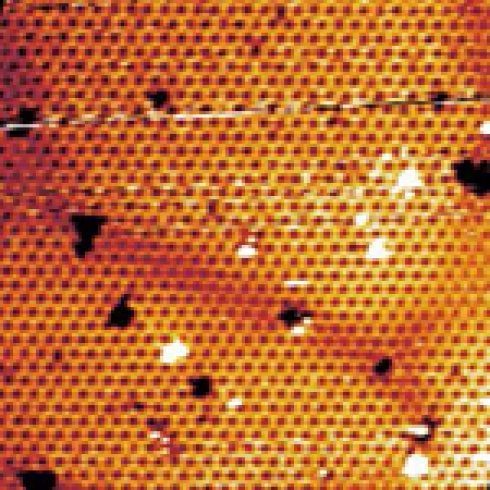New materials compete with graphene for the future of electronics
April 30, 2012

Scanning tunneling microscope image of the 2D honeycomb structure of silicene (credit: Patrick Vogt/TU Berlin)
Two research groups have invented two new materials that may compete with graphene as the solution for faster, more powerful electronic devices of the future.
- MIT researchers have created a thin film of bismuth-antimony that allows electrons to “travel like a beam of light” — hundreds of times faster than in conventional silicon chips.In thermoelectric generators and coolers, the faster electron flow (and ability to function as an insulator) might lead to much more efficient power production. The new material could even allow for designing electronic devices made of the same material with varying properties, deposited one layer atop another, rather than layers of different materials.
- Researchers at Technical University in Germany and Aix-Marseille University in France created silicine by condensing silicon vapor onto a silver plate to form a single layer of atoms, New Scientist reports. The new material may lead to smaller, cheaper electronic devices than graphene because it can be integrated more easily into silicon chip production lines.
- However, for solar cells, adding graphene to the titanium dioxide in dye-sensitized solar cells increases the current by more than 50%, Michigan Technological University materials scientists have discovered. Dye-sensitized solar cells don’t rely on rare or expensive materials, so they could be more cost-effective than cells based on silicon and thin-film technologies.
Ref.: Patrick Vogt et al., Silicene: Compelling Experimental Evidence for Graphenelike Two-Dimensional Silicon, Physical Review Letters, 2012, DOI: 10.1103/PhysRevLett.108.155501
Ref.: Shuang Tang et al., Constructing Anisotropic Single-Dirac-Cones in Bi1–xSbx Thin Films, Nano Letters, 2012, DOI: 10.1021/nl300064d
Ref.: Yun Hang Hu, Application of Graphene for Solar Cells, US-Egypt Joint Workshop on Solar Energy Systems, 2012 [PDF]